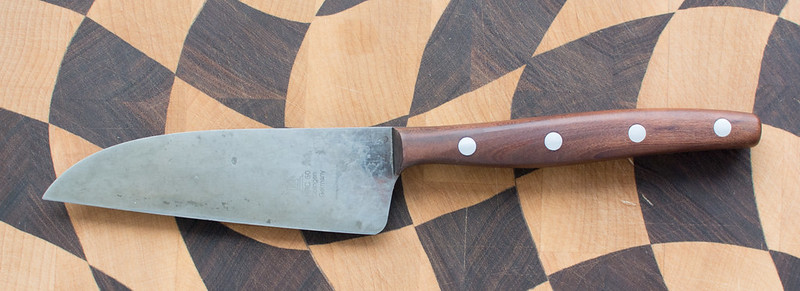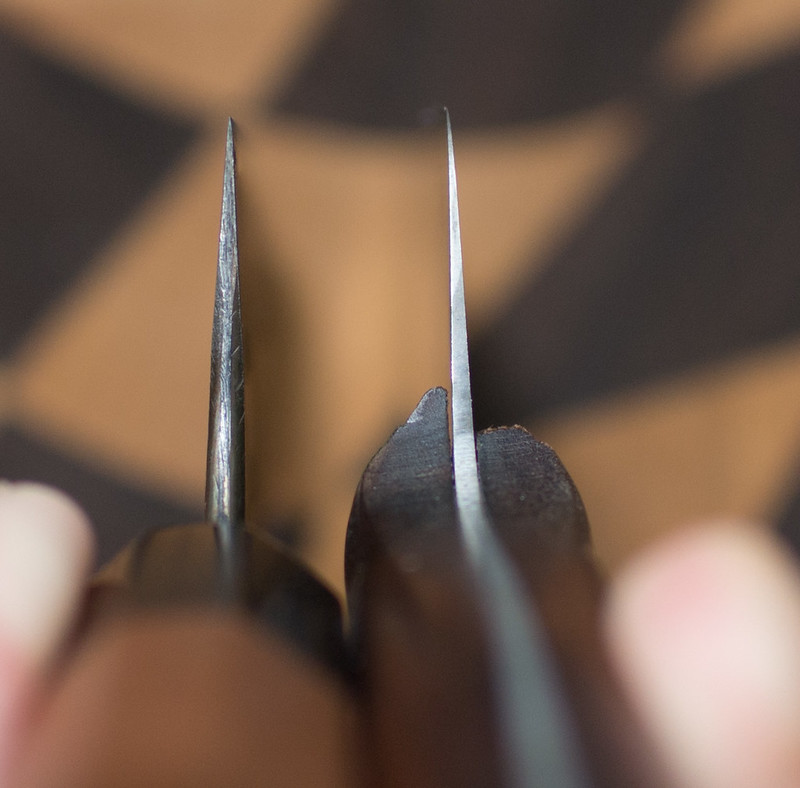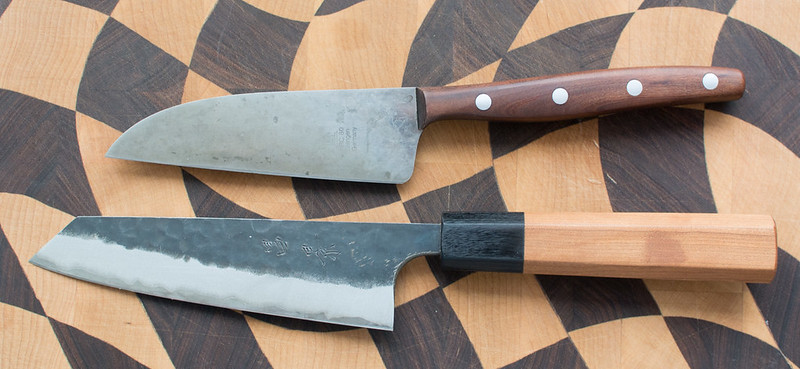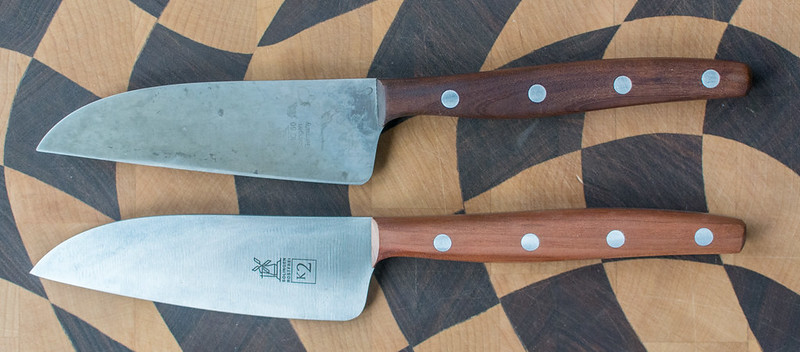Hi,
this review is long due and I finally got around to put it together (the Haburn AEB-L gyuto will come in few weeks - I promise )
)
A little introduction first:
Windmuehle knives are made by Robert Herder manufacture in Solingen in Germany. While these knives can not be really discerned as fully hand made, they are still made using techniques ore than 100 years old and are part of Germany knife making legacy. My interest in these knives was mostly fuelled by curiosity - there knives are on one hand very different from Japanese cutlery, but at the same time also different from modern European knives.
There are several different lines + a lot of cheaper knives which I would group here as "standard knives". The produce both stainless and carbon knives. The relevant lines are firstly the K line and 1922 line. The knives in K line come in both carbon and stainless steel, the 1922 only in carbon (which is most probably the same steel as the K carbon knives). The webpage of the company is pretty much useless, the most informative page I was able to find is here (no connection)
The 1922 series is form-forged (in one step by automatic hammer), the rest of the knives is stamped out of stock material and further processed. The following videos (in German language) will give you quite a good idea how these knives are made:
(direct linking was not possible as KKF only allows one video per message)
youtube.com/watch?v=uEXjQ3yDoHE
youtube.com/watch?v=9cscGvvll4c
youtube.com/watch?v=4sfcDHMkLpU
youtube.com/watch?v=LQKHiL3jrGg
The carbon steel (depending on knife) is either C60, C75 or C100 (?) which are simple carbon steels with carbon content 0.6% - 1.0% The stainless steel is some sort of Mo-V steel. The higher-end knives are hardened to around HRC60.
All the knives share very thin grinds which are either flat, or convex. The higher end blades get additionally a separate surface finish step called "Blaupliesten" which involves polishing of the surface with some special paste that gives the knife slightly bluish look and should improve rust resistance on carbon knives.
The handles on Herder knives are mostly made from cherry, walnut, plum and olive wood. The better Herder knives have their handles polished with some paste. The cheap knives have no surface finish.
The review of K2 knife:
I have had the chance to use the K2 carbon knife with cherry wood handle kindly borrowed to me by KKF member riba (thanks a lot!). At this point I would like to say the carbon knife tested here is bout 2 years old and had a forced patina (mustard and vinegar) by its owner. I have also ordered a stainless K2 with cherry wood for the sake of comparison of the two different steels compare and get the idea on handle ageing.
The K2 (see bellow) is a smaller santoku - like shaped knife. A little too small for my taste, but the shape is interesting.

So - the measurements of the blade:
- heel to tip: 108 mm
- height at the heel: 33 mm
- width of the spine above the heel: 1.7 mm (thickness of the stock steel)
- width of the spine in the middle: 1.5 mm
- width of the spine 1cm from the tip: 0.6 mm
When the knife arrived it was actually quite sharp and had well maintained edge, although riga told me the knife did not see much use and gave me permission to sharpen the knife. So I took on that promise and used my Gesshin 2k and 6k to touch up the blade. It was very easy and very fast. That had to do with both thinness of the blade and not too hard steel. That was nearly 2 months ago. Although the knife was not used every day, it was used often and the edge, while not shaving sharp anymore (since a while that way), is still usable today and goes through hard cheese with ease. Again the thinness has certainly something to do with that. Concerning how thin this knife is - it is substantially thinner than my carbon clad Carter or Masakage Koishi ko-bunka.
Here comparison of grinds to my Masakage ko-bunka (K2 is on the right):

The blade grind is slightly convex - nearly flat, so there is no "shoulder" to be found. That also means that there is not much of a food release, but also a complete lack of wedging. The blade as medium amount of flex and some more towards the tip which is very thin. Since the blade is short the flex does not really show, but I would hope that the longer blades are made from slightly thicker stock to keep the flex in reasonable range.
The handle. Well - this is a simple cherry wood handle, a well aged one. It expanded a little (one could feel the edges around the pins a bit) and it could use some board butter. Comparing it to the handle on the brand new stainless K2 - I would recommend to wax it several times before going anywhere close to water. The handle on the K2 is rather thin, but it is not uncomfortable to use. After all - this is not a knife that you would use with lot of force.
View from the top:

Short comparison with Masakage Koishi ko-bunka (130mm):
While these two knives can be used for similar purpose, they are very different. The masakage is much stiffer, has more belly towards the tip - which is important as I found myself hitting the cutting board with the tip with the K2 because the blade profile is so flat. The K2 goes easier through hard veggies as the grind is so thin. The Masakage holds edge much better, but that is to be expected with super blue steel. Still - the K2 is actually holding up better that I have expected.

Carboon vs stainless: As mentioned already - I have also ordered the K2 in stainless steel to see how it compares. First of all - the grinds are VERY similar and the stock seems to have the same thickness. The stainless K2 has a little more belly, but that might either be product variation, or the carbon one lost some if it during its life. The stainless K2 does have little more flex than the carbon one. The image below shows also the difference in new and 2 years old cherry wood handle.

Summary:
The K2 knife is a little interesting knife. While this particular model is bit too small for my taste, I will probably order the K4 in carbon stell. The steel is not really comparable to what we got used in Japanase made knives, but it does hold up to regular use, is extremely easy to sharpen and deburr - advantage if you have only very basic sharpening skills and equipment. There is one more very interesting knife from Herder called "Robert Koch B1 Flachschmieder" where the meaning of the long german word is "flat forged". This knife is forged by Rudolf Koch from Solingen and then finished by Hereder. It is pricey, but in my opinion has very interesting blade and handle shape. I am still considering to try it out.
The Herder knives while to as 'high end' as others do offer an interesting alternative and bit of different knife making philosophy.
If you have any questions just ask
this review is long due and I finally got around to put it together (the Haburn AEB-L gyuto will come in few weeks - I promise
A little introduction first:
Windmuehle knives are made by Robert Herder manufacture in Solingen in Germany. While these knives can not be really discerned as fully hand made, they are still made using techniques ore than 100 years old and are part of Germany knife making legacy. My interest in these knives was mostly fuelled by curiosity - there knives are on one hand very different from Japanese cutlery, but at the same time also different from modern European knives.
There are several different lines + a lot of cheaper knives which I would group here as "standard knives". The produce both stainless and carbon knives. The relevant lines are firstly the K line and 1922 line. The knives in K line come in both carbon and stainless steel, the 1922 only in carbon (which is most probably the same steel as the K carbon knives). The webpage of the company is pretty much useless, the most informative page I was able to find is here (no connection)
The 1922 series is form-forged (in one step by automatic hammer), the rest of the knives is stamped out of stock material and further processed. The following videos (in German language) will give you quite a good idea how these knives are made:
(direct linking was not possible as KKF only allows one video per message)
youtube.com/watch?v=uEXjQ3yDoHE
youtube.com/watch?v=9cscGvvll4c
youtube.com/watch?v=4sfcDHMkLpU
youtube.com/watch?v=LQKHiL3jrGg
The carbon steel (depending on knife) is either C60, C75 or C100 (?) which are simple carbon steels with carbon content 0.6% - 1.0% The stainless steel is some sort of Mo-V steel. The higher-end knives are hardened to around HRC60.
All the knives share very thin grinds which are either flat, or convex. The higher end blades get additionally a separate surface finish step called "Blaupliesten" which involves polishing of the surface with some special paste that gives the knife slightly bluish look and should improve rust resistance on carbon knives.
The handles on Herder knives are mostly made from cherry, walnut, plum and olive wood. The better Herder knives have their handles polished with some paste. The cheap knives have no surface finish.
The review of K2 knife:
I have had the chance to use the K2 carbon knife with cherry wood handle kindly borrowed to me by KKF member riba (thanks a lot!). At this point I would like to say the carbon knife tested here is bout 2 years old and had a forced patina (mustard and vinegar) by its owner. I have also ordered a stainless K2 with cherry wood for the sake of comparison of the two different steels compare and get the idea on handle ageing.
The K2 (see bellow) is a smaller santoku - like shaped knife. A little too small for my taste, but the shape is interesting.

So - the measurements of the blade:
- heel to tip: 108 mm
- height at the heel: 33 mm
- width of the spine above the heel: 1.7 mm (thickness of the stock steel)
- width of the spine in the middle: 1.5 mm
- width of the spine 1cm from the tip: 0.6 mm
When the knife arrived it was actually quite sharp and had well maintained edge, although riga told me the knife did not see much use and gave me permission to sharpen the knife. So I took on that promise and used my Gesshin 2k and 6k to touch up the blade. It was very easy and very fast. That had to do with both thinness of the blade and not too hard steel. That was nearly 2 months ago. Although the knife was not used every day, it was used often and the edge, while not shaving sharp anymore (since a while that way), is still usable today and goes through hard cheese with ease. Again the thinness has certainly something to do with that. Concerning how thin this knife is - it is substantially thinner than my carbon clad Carter or Masakage Koishi ko-bunka.
Here comparison of grinds to my Masakage ko-bunka (K2 is on the right):

The blade grind is slightly convex - nearly flat, so there is no "shoulder" to be found. That also means that there is not much of a food release, but also a complete lack of wedging. The blade as medium amount of flex and some more towards the tip which is very thin. Since the blade is short the flex does not really show, but I would hope that the longer blades are made from slightly thicker stock to keep the flex in reasonable range.
The handle. Well - this is a simple cherry wood handle, a well aged one. It expanded a little (one could feel the edges around the pins a bit) and it could use some board butter. Comparing it to the handle on the brand new stainless K2 - I would recommend to wax it several times before going anywhere close to water. The handle on the K2 is rather thin, but it is not uncomfortable to use. After all - this is not a knife that you would use with lot of force.
View from the top:

Short comparison with Masakage Koishi ko-bunka (130mm):
While these two knives can be used for similar purpose, they are very different. The masakage is much stiffer, has more belly towards the tip - which is important as I found myself hitting the cutting board with the tip with the K2 because the blade profile is so flat. The K2 goes easier through hard veggies as the grind is so thin. The Masakage holds edge much better, but that is to be expected with super blue steel. Still - the K2 is actually holding up better that I have expected.

Carboon vs stainless: As mentioned already - I have also ordered the K2 in stainless steel to see how it compares. First of all - the grinds are VERY similar and the stock seems to have the same thickness. The stainless K2 has a little more belly, but that might either be product variation, or the carbon one lost some if it during its life. The stainless K2 does have little more flex than the carbon one. The image below shows also the difference in new and 2 years old cherry wood handle.

Summary:
The K2 knife is a little interesting knife. While this particular model is bit too small for my taste, I will probably order the K4 in carbon stell. The steel is not really comparable to what we got used in Japanase made knives, but it does hold up to regular use, is extremely easy to sharpen and deburr - advantage if you have only very basic sharpening skills and equipment. There is one more very interesting knife from Herder called "Robert Koch B1 Flachschmieder" where the meaning of the long german word is "flat forged". This knife is forged by Rudolf Koch from Solingen and then finished by Hereder. It is pricey, but in my opinion has very interesting blade and handle shape. I am still considering to try it out.
The Herder knives while to as 'high end' as others do offer an interesting alternative and bit of different knife making philosophy.
If you have any questions just ask




